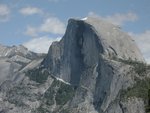Date: April 25, 2011
Contact: Maureen Oltrogge, 928-538-7779
Contact: Marybeth Garmoe, 928-638-7651
Grand Canyon, Ariz. – Throughout the upcoming field season, National Park Service staff will be applying herbicide to targeted high priority invasive plant species in Grand Canyon National Park's developed areas. Developed areas of the park have increased levels of human disturbance, which contribute to the high concentration of invasive plants in these areas.
Vegetation Program staff are attempting to restrict the spread of invasive plant species, reduce the number of high priority invasive species, and improve native habitat in areas where they are located.
In spring of 2009, an Environmental Assessment (EA) was prepared for implementation of the park's Exotic Plant Management Plan and a Finding of No Significant Impact was signed by the Regional Director in July of 2009. The EA identifies the need to use an integrated approach to managing exotic plant species, which includes the use of herbicide when it is the most effective and efficient tool to accomplish program goals. All herbicides planned for use in the development zones are rated low toxicity and have been reviewed and approved by the National Park Service's Regional Integrated Pest Management Coordinator.
Herbicide will only be used on species considered high priority for control in the park and which are not easily controlled using non-chemical methods. Species that fall within this category include Dalmatian toadflax (Linaria dalmatica) and Rush skeletonweed (Chondrilla juncea), both of which have extensive underground root systems causing mechanical control methods to be ineffective. Also targeted with herbicides are Siberian elm (Ulmus pumila) and tamarisk (Tamarix ramosissima), which will continually resprout without the use of herbicide when cut. Finally, species such as puncturevine (Tribulus terrestris) and jointed goatgrass (Aegilops cylindrica) may be treated with herbicide due to the inefficiencies involved in mechanically treating extensive populations of countless individuals.
All herbicide use will be closely monitored to assure that negative impacts to native vegetation, wildlife and humans are minimized. Herbicide will be applied using only hand or backpack sprayers, which focus the herbicide spray directly on the targeted plants. Areas in which herbicide applications are planned will be appropriately signed and/or flagged to warn residents and visitors to avoid the area. Signs will be removed once the herbicide has dried and it is safe for re-entry. When applying herbicide in residential areas, residents will be notified at least 24 hours prior to the application and will be instructed to keep children and pets out of the application area until the spray has dried.
Specific areas that have been identified for herbicide use include:
- Adjacent to the railroad tracks
- Rim lodges and Verkamp's Visitor Center
- Xanterra South Rim L.L.C., General Offices
- Power House and mule barns
- Grand Canyon Visitor Center
- Backcountry Information Center
- Ranger Operations
- Labor Cabins near Tonto Street
- Utility Corridor west of the Grand Canyon Clinic
- Grand Canyon School (herbicide will not be used while school is in session)
- South Entrance Station and South Entrance Road
- Rowe Well drainage
- Mather Campground access road
- Coconino Apartments
- Trailer Village
- Village Loop
- Apache Street
- Havasupai Street
- Zuni Way
- Pinyon Park
- Kaibab Street
- Market Plaza Road
- Navajo Street
- Desert View Visitor Center and East Entrance Station
- Indian Garden
For more information, please contact Marybeth Garmoe, Invasive Plant Biologist, at 928-638-7651.


